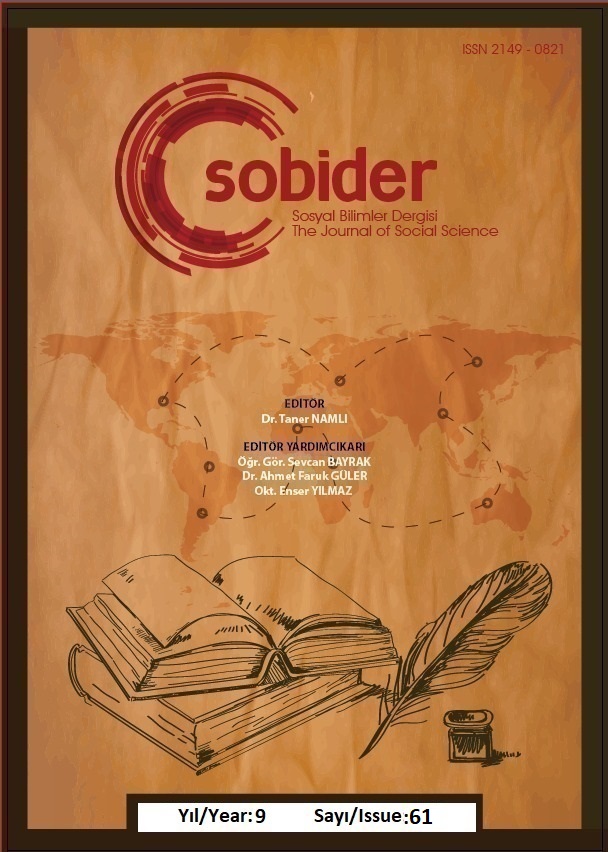Author :
Abstract
Modern sanatın ortaya çıkış dinamikleri düşünüldüğünde o dönem, birinci sanayi devrimi kendini tam anlamıyla hissetirmekte makineleşme ve seri üretim anlayışı hemen hemen her alana sirayet ettiği gibi sanata ve sanatçıların üretim süreçlerine de etki eden bir dönem olarak kabul etmek makul bir düşünce sayılacaktır. Özellikle fotoğraf makinesinin icad edilip yaygın bir biçimde kullanılmasının ardından dönemin sanatçıları önceleri bu durumun kendilerini olumsuz yönde etkileyeceğini düşünmüş ancak daha sonra makinenin yapamadığını yapabilmek anlayışı ışığında ve hatta teknolojik gelişmeleri yine teknolojiye karşı bir enstürman olarak kullanan (Boyayı tüplerde muhafaza etmek v.b.) sanatçı artık doğadaki varlıkların birebir temsiliyetinden vazgeçip renk ve biçim arayışlarına girmiştir. Sanatçı doğayı değiştirip dönüştürüp bazen formun özünü bulmaya çalışmış bazen de doğada var olmayan biçimleri aramıştır. Bu arayışlar neticesinde ortaya çıkan İzlenimcilik akımımını modern sanatın miladı olarak kabul etmek mümkündür. İzlenmcilik akımını takiben Expresyonizm, Kübizm, Fütürizm, Soyut Sanat, Dada, Rus Konstrüktivizm’i ve Almanya’da ortaya çıkan Bauhaus okulları gibi bir çok akım ve sanat anlayışı da ortaya çıkmıştır (Bulat, S. Bulat, M., Aydın, B.,2014:105) Doğal olarak bu sanatsal arayışlar resim sanatını etkilediği gibi heykel sanatını da etkilemiş ve yapısal reformlara yol açmıştır. Bu yenilikler ise doğada var olan biçimlerin en yalın hallerinin ele alındığı soyutlama form arayışları ile doğadaki varlıklara hiç benzemeyen ve saf sanat olarak kabul gören soyut formların ortaya çıkmasına sebep olmuştur. Bu sanatsal düşüncelere hem felsefik hem de üretim bağlamında öncülük eden ressamların heykel sanatına verdikleri katma değeri ele aldığımızda bu santçıların sadece resim sanatına değil heykel sanatına da önemli fikirler ve teknikler kazandırdıkları görülmektedir. Bu minvalde söz konusu araştırma da modern heykele katkı sunmuş bazı sanatçıların sanatsal anlayışları ve üretim süreçleri ele alınmıştır.
Keywords
Abstract
Considering the dynamics of the emergence of modern art, that period was the first industrial revolution, and it would be reasonable to accept it as a period that affected art and the production processes of artists, as the understanding of mechanization and mass production spread to almost every field. Especially after the invention of the camera and its widespread use, the artists of the period thought that this situation would affect them negatively, but later on, in the light of the understanding of doing what the camera could not do, and even using the technological developments as an instrument against technology (preserving the paint in tubes, etc.) gave up its one-to-one representation and started to search for color and form. By changing and transforming nature, the artist sometimes tried to find the essence of the form and sometimes sought forms that do not exist in nature. It is possible to accept the Impressionism movement, which emerged as a result of these searches, as the milestone of modern art. Following the Impressionism movement, many movements and artistic understandings such as Expressionism, Cubism, Futurism, Abstract Art, Dada, Russian Constructivism and Bauhaus schools emerged in Germany. Naturally, these artistic pursuits affected the art of painting as well as the art of sculpture and led to structural reforms. These innovations, on the other hand, have led to the emergence of abstract forms, which are not at all similar to the beings in nature and accepted as pure art, with the search for abstraction forms in which the simplest forms of nature are handled. When we consider the added value given to the art of sculpture by the painters who pioneered these artistic ideas both philosophically and in the context of production, it is seen that these artists brought important ideas and techniques not only to the art of painting but also to the art of sculpture. In this way, the artistic understanding and production processes of some artists who contributed to modern sculpture were discussed in this research.
Keywords
- Altunışık, R. Çoşkun, R. Yıldırım, E. ve S. Bayraktaroğlu, (2010). Sosyal Bilimlerde Araştırma Yöntemleri. 6.Baskı, Sakarya: Sakarya Kitabevi.
- Antmen, A. (2009). 20.Yüzyıl Batı Sanatında Akımlar, Sel Yayıncılık, İstanbul.
- Bulat, M. (2014). Modern Sanatta Soyutlama, (Birinci Basım), Atatürk Üniversitesi Yayınları, Erzurum
- Bulat,S., (1999). Teknoloji ve Heykel Sanatı, Atatürk Üniversitesi, Güzel Sanatlar Fakültesi Sanat Dergisi. Yıl 1999, Cilt 0, Sayı 1, s. 133-140
- Bulat, S. Bulat, M., Aydın, B.,(2014), Bauhause Tasarım Okulu, Atatürk Üniversitesi Sosyal Bilimler Enstitüsü Dergisi 18 (1): s.105
- Daşkesen, H. (2021), Çağdaş Heykel Sanatında Kültürel Kimliği Konumlandırmak: Wolfgang Laib’in Yapıtları Üzerinden Bir Değerlendirme, The Turkish Online Journal of Design, Ekim 2021, Cilt 11 Sayı 4, s.1285-1302
- Gombric, E.,H., (1986). Sanatın Öyküsü Başlangıçtan Günümüze Sanat Tarihi; Resim, Heykel,
- Farthing, S., (2014). Sanatın Tüm Öyküsü, F. C. Çulcu ve G. Aldoğan (Çev.), Hayalperest Kitabevi, İstanbul.
- Kandinsky, W. (2010). Sanatta Ruhsallık Üzerine, Altıkırkbeş Yayın, İstanbul.
- Karasar, N. (2008). Bilimsel Araştırma Yöntemi, Nobel Yayın Dağıtım, Ankara.
- Lynton, N., (1982), Modem Sanatın Öyküsü, (Çev. Sadi Öziş), İstanbul.
- Şengünalp, C. (2019). Sanayi Sonrası Kentleşme Sürecinde Heykelin Mekânsal İşlevi, idil, 64 (Aralık), 1609-1623.
- Thomas, K., (1990), From van Gogh to Picasso, From Kandinsky to Pollock. Masterpieces of Modern Art, Solomon R. Guggenheim Museum Publish, New York.
- Tunalı, İ. (2004), Estetik, Remzi Kitapevi, İstanbul.
- Turani, A. (2010), Dünya Sanat Tarihi, İstanbul, Türkiye İş Bankası Kültür Yayınları, İstanbul.
- Yıldırım, A. ve H. Şimşek. (2008). Sosyal bilimlerde Nitel Araştırma Yöntemleri, Ankara: Seçkin Yayınları.
- Yağmur, Ö. (2017). Düşünceden 3 Boyutlu Tasarıma Yönelik Bir Uygulama: Heykeli Giymek, The Turkish Online Journal of Design , Art and Communication, Volume 7, Issue 3.





